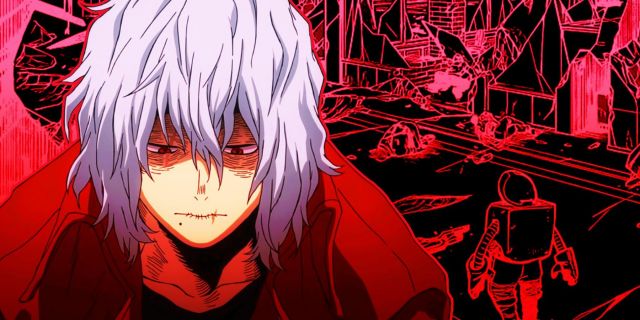My Hero Academia‘s final story arc took the series in a truly dark direction after the heroes fought the Paranormal Liberation Front for the first time. The worn-out professional heroes are unable to keep up with the horrific era of disorder, crime, and devastation that Tomura Shigaraki, the new face of evil, helped usher in. The narrative, however, didn’t properly examine this important historical period.
There are numerous ways My Hero Academia might have shown the breakdown of hero society, which is a fundamental storyline aspect in all stories. Unfortunately, Kohei Horikoshi was pressured to finish his manga at a faster rate at the price of giving his story’s most historic turn of events a significant payout.
My Hero Academia Didn’t Fully Demonstrate the Collapse of the Hero Society
Around the time Midoriya adopted his “Dark Deku” persona, the villains had practically won, and hero society came crashing down. The new #1 hero Endeavor was disgraced as Toya Todoroki’s abusive father, meaning the world lacked a symbol of peace to rally around and push back the darkness. The consequences of society’s collapse into violent anarchy were enormous — except My Hero Academia‘s manga and anime both failed to convey the full scope of the chaos.
Instead, the series only briefly touched on the age of chaos and villainy, such as depicting shop owners fighting off thieves and robbers with makeshift weapons and their low-power Quirks, or the terrified commotion at the UA school when the masses originally refused to let Midoriya in. The popular, fox-themed Ordinary Woman made an appearance in that arc, an innocent civilian whom Midoriya protected from the violent anarchy. However, there were innumerable Ordinary Woman victims in Japanese culture, and the manga did not depict the entire scope of the situation. The Ordinary Woman was reduced to being a charming minor character, barely representative of society’s ills.
This lowers the emotional impact of the Ordinary Woman’s experience, as so few other victims across Japan were seen, and it also lowers the stakes for the final fight. Currently, in the MHA manga, Midoirya is preparing to fight Tomura Shigaraki, and the Todoroki family is trying to redeem and save Dabi, all to protect what’s left of the fallen hero society. So far, these events play out like character dramas between MHA’s major players, with the societal stakes being implied but not properly shown. MHA fans need to see the desperate crowds of people all over the nation who need Midoriya and the Todorokis to win, all to create proper stakes for MHA’s endgame. So far, however, those stakes are too subtle to have any real impact.
Kohei Horikoshi Was Compelled to Speed Up the Story
My Hero Academia fans find it disappointing that the final arc isn’t properly conveying the full scope of the anarchy and violence that’s rocking Japan, but there may be a few reasons why Horikoshi merely glossed over it. As some fans have noted, Horikoshi got a new editor around the time society collapsed in My Hero Academia, who wanted him to accelerate the story. Horikoshi once intended for My Hero Academia to complete with Eiichiro Oda’s long-running One Piece, but then he reversed his position and declared that My Hero Academia would end within a year or so. This means that supporting details like the full scope of society’s collapse must be minimized so the story can focus on the popular main characters who keep readers engaged.
Another prevalent idea holds that Horikoshi was prohibited from delving too deeply into the chaos and sorrow depicted in his manga due to Japanese societal conventions and taboos. It’s nearly unheard of in manga and anime for a plot to spotlight villains like Dabi and make them sympathetic, so Horikoshi’s decision to create the “My Villain Academia” arc was already a significant risk. Perhaps truly examining the horrific chaos of Japan’s post-hero society would be too much for the author, so he only skimmed over it to make his point. If that’s the case, it was an unfortunate but clearly necessary choice for him to make, restricting the story’s largest and most crucial stakes thus far in order to focus on the character-driven tales that fans want to see.















Leave a Reply